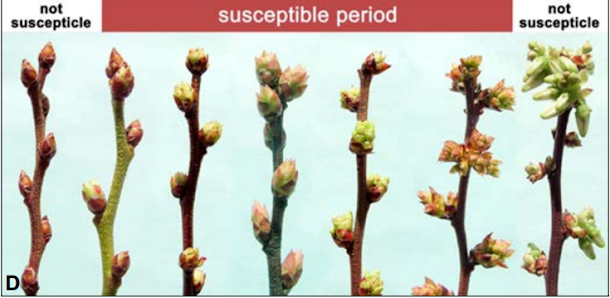This update includes frost advisory and blueberry frost risks, monilinia infection period, and recommendations on field activities.
Frost Advisory and Blueberry Frost Risks
Frost Advisories are issued
in Annapolis, Colchester (Cobequid Bay, Truro and South, North), Cumberland
(Minas Shore, North and Cobequid Pass), Digby, Hants and Kings. https://weather.gc.ca/warnings/index_e.html?prov=ns.
Please check the
link above for areas in the province affected by frost this evening.
As we are starting
to see open flowers and bee hives ready to go out, concerns raised about spring
frost injury.
Frost injury is a combination
of low temperatures, freeze duration and plant growth stage.
As blueberry plants
advance into the bloom stage, they are less tolerant to cold than when they are
in the bud stages. Please check the figure below for general blueberry stages
and each stage’s minimum cold tolerance temperature. When blueberry plants have
fully open flowers, any temperature below -2.2c for a couple of hours could
damage those flowers.
Figure
1. Blueberry Frost Risks
Monilinia Infection Period
We had an infection period for the last two days
through most areas in the provinces. Besides late fields and the Cape Breton
area, most fields are quickly approaching the end of the blight infection
season. Flowers are starting to open and some growers are starting to put bees
out this weekend.
In Cape Breton, just by talking to growers in the area, it is at the 40% F2 stage so closely monitoring weather conditions in those areas is important for growers managing fields in Cape Breton. Fields that have just reached the 40% F2 stage would be susceptible to infection.
Figure 2. Wild blueberry susceptible stages to monilinia blight infection
We had a small infection period (the first one for the
season for most areas) starting May 4 evening to May 5 morning, but at this
time, I haven’t seen any symptoms of infection. I will report if I start to see
symptoms.
Recommendations on Field Activities
Pollination:
For the last two
weeks, we observed fast plant development and flowers are starting to open. In
some fields and areas, it is ready for pollination. I already heard from a
couple of growers who already placed their hives in fields and some are
considering putting them out this weekend. Please start your communication with
your beekeepers and make sure you talk to them if you decide to spray any
products when bees are in the fields.
Botrytis blight:
If you are in
areas where typically more prone to botrytis infection, such as coastal areas,
wet/fog areas and if your fields are weedy (sheep sorrel is an important host)
with very dense patches, you should consider and monitor the situation for
treatment application. The fungus begins to sporulate at early bloom, so the
best time to apply (if needed!) the first application is when about 30-40% of
the flowers are open. Closed flowers are resistant to infection. A second spray
can be applied about 7-10 days later.


